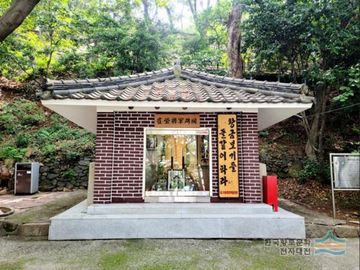"최영 장군 사당(부산)"의 두 판 사이의 차이
(→영문) |
(→영문) |
||
| 32번째 줄: | 32번째 줄: | ||
This shrine is dedicated to Choe Yeong (1316-1388), a renowned army general of the Goryeo period (918-1392). | This shrine is dedicated to Choe Yeong (1316-1388), a renowned army general of the Goryeo period (918-1392). | ||
| − | Known as an honest person of high integrity, Choe lived his life under the motto “look at gold as you would look at stone. | + | Known as an honest person of high integrity, Choe lived his life under the motto “look at gold as you would look at stone.” Choe began his military career in the Central Army as a guard of the royal palace in the capital (present-day Gaeseong, North Korea). In 1354, he was promoted to commander of the Central Army. Later, he successfully suppressed the Japanese pirates that were devasting Korea’s coastal areas, pacified several domestic rebellions, and protected the country against outside aggression. His strong leadership and sophisticated war tactics earned him wide recognition even in Yuan China. One of his greatest victories was at the Battle of Hongsan (in present-day Buyeo) in 1376, where his army obliterated the Japanese pirates. It is said that after this defeat, the pirates lost their fighting spirit and fled whenever they saw Choe’s flag. |
Present-day Busan, including the Gamman-dong, Suyeong-dong, Yeongdo, and Jaseongdae areas, was also one of the places that General Choe helped protect from the Japanese pirates. He came to be considered a guardian spirit of the local area, and this shrine was established to commemorate his contributions. Each year, a veneration ritual is performed for him here on the fifth day of the fifth lunar month. | Present-day Busan, including the Gamman-dong, Suyeong-dong, Yeongdo, and Jaseongdae areas, was also one of the places that General Choe helped protect from the Japanese pirates. He came to be considered a guardian spirit of the local area, and this shrine was established to commemorate his contributions. Each year, a veneration ritual is performed for him here on the fifth day of the fifth lunar month. | ||
*내용의 순서를 약간 수정했어요. | *내용의 순서를 약간 수정했어요. | ||
| + | *‘황금 보기를 돌같이 하라’는 말은 욕심 뿌리지 말라는 말인가요? 그 정확한 의미를 같이 설명하면 좋을 것 같아요. | ||
===영문 해설 내용=== | ===영문 해설 내용=== | ||
2022년 6월 17일 (금) 10:14 판
| 최영 장군 사당 |
|
 최영 장군 사당, 부산역사문화대전, 한국학중앙연구원. |
|
| 대표명칭 | 최영 장군 사당 |
|---|---|
| 한자 | 崔瑩 將軍 祠堂 |
| 주소 | 부산광역시 동구 자성로 99[범일동 590-5] |
해설문
국문
최영장군은 고려 충숙왕 3년(서기1316년)에 출생하셨다. 장군은 성품이 강직하고 청렴하여 왕실(王室)의 숙위병(宿衛兵)으로 근무하였고 공민왕 3년에는 대호군(大護軍)이 되어 수차에 걸쳐 내‧외란을 평정하여 그 용맹하이 원나라 까지 이름을 떨쳤으며 특히 홍산(鴻山) 싸움에서는 왜구를 크게 무찔러 왜구가 최영장군을 백수 최만호(白首 崔萬戶)라 하여 장군의 이름만 들어도 몹시 무서워하게 되었다. 전장에서 최장군의 기(旗)가 보이면 왜구들은 전의(戰意)를 잃고 도주하였다는 사실은 장군의 전술이 신출귀몰하였고 탁월한 군의 통솔력을 말해주는 것이다.
장군은 황금을 보기를 돌같이 하여 일편단심으로 나라를 위하였고 장군의 구국정신은 민족의 혼이 되어 우리가슴에 나아 부산 연해의 각처(감만동, 수영동, 영도, 자성대)에 왜구를 섬멸한 장군의 고마움을 하나의 신앙(信仰)으로 승화시켜 사당을 지어 마을 수호신으로 장군의 영을 모시면서 매년 단오(음력 5월 5일)에 제사를 지낸다.
영문
Shrine of General Choe Yeong
This shrine is dedicated to Choe Yeong (1316-1388), a renowned army general of the Goryeo period (918-1392).
Known as an honest person of high integrity, Choe lived his life under the motto “look at gold as you would look at stone.” Choe began his military career in the Central Army as a guard of the royal palace in the capital (present-day Gaeseong, North Korea). In 1354, he was promoted to commander of the Central Army. Later, he successfully suppressed the Japanese pirates that were devasting Korea’s coastal areas, pacified several domestic rebellions, and protected the country against outside aggression. His strong leadership and sophisticated war tactics earned him wide recognition even in Yuan China. One of his greatest victories was at the Battle of Hongsan (in present-day Buyeo) in 1376, where his army obliterated the Japanese pirates. It is said that after this defeat, the pirates lost their fighting spirit and fled whenever they saw Choe’s flag.
Present-day Busan, including the Gamman-dong, Suyeong-dong, Yeongdo, and Jaseongdae areas, was also one of the places that General Choe helped protect from the Japanese pirates. He came to be considered a guardian spirit of the local area, and this shrine was established to commemorate his contributions. Each year, a veneration ritual is performed for him here on the fifth day of the fifth lunar month.
- 내용의 순서를 약간 수정했어요.
- ‘황금 보기를 돌같이 하라’는 말은 욕심 뿌리지 말라는 말인가요? 그 정확한 의미를 같이 설명하면 좋을 것 같아요.
영문 해설 내용
이곳은 고려시대의 명장인 최영(1316-1388)을 기리는 사당이다. 장군은 성품이 강직하고 청렴하였으며, ‘황금 보기를 돌같이 하라’는 말을 평생의 좌우명으로 삼았다. 왜구를 토벌하는 데 공을 세운 후 왕실을 호위하는 숙위병으로 근무하였고 1354년에는 중앙군의 지휘관인 대호군이 되었다. 수차에 걸쳐 내‧외란을 평정하여 그 용맹함이 원나라까지 이름을 떨쳤다. 특히 1376년 지금의 부여 지역에서 벌어진 홍산대첩에서는 왜구를 크게 무찔러, 왜구가 최영 장군의 이름만 들어도 몹시 무서워하게 되었다. 전장에서 장군의 깃발이 보이면 왜구들은 전의(戰意)를 잃고 도주하였다고 하며, 이는 장군의 전술이 신출귀몰하고 군 통솔력이 탁월했음을 말해주는 것이다.
최영 장군은 부산 지역에서 지금의 감만동, 수영동, 영도, 자성대 일대에서 왜구를 섬멸하였다. 이러한 공적을 기리기 위해 주민들은 최영 장군을 숭배하는 사당을 지었고, 장군을 마을 수호신으로 모시면서 매년 음력 5월 5일에 제사를 지낸다.
- 언제 지은 사당인지 확인 필요.